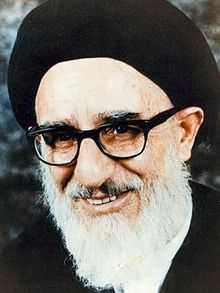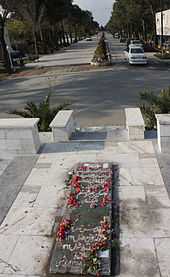Mahmoud Taleghani
| Muslim scholar Ayatollah Mahmoud Taleghani | |
|---|---|
 | |
| Born | 1911 |
| Died | 9 September 1979 (aged 67–68) |
| Era | Modern era |
| Main interest(s) | Fiqh, Kalam and philosophy |
|
Influenced by
| |
Mahmoud Taleghani (1911 – 9 September 1979) was an Iranian theologian, humanist, Muslim reformer, democracy advocate and a senior Shi'a cleric of Iran. Taleghani was a contemporary of the Iranian Revolutionary leader Ayatollah Ruhollah Khomeini and a leader in his own right of Iran's Shi'a resistance movement against the pro-western, secularist Shah Mohammad Reza Pahlavi. A founding member of the Freedom Movement of Iran, he has been described as a representative of the tendency of many "Shia clerics to blend Shia with Marxist ideals in order to compete with leftist movements for youthful supporters" during the 1960s and 1970s.[1] His "greatest influence" has been said to have been in "his teaching of Quranic exegesis," as many later revolutionaries were his students.[2]
Biography

Taleghani was born to a religious family in the village of Galird of Taleqan County in Northern Iran in 1911.[3] His father taught him Islamic sciences and he continued his studies in Qom, studying the same subject at the Razaviya and Fayziya schools. In 1938 he went to Tehran to preach and lecture on Islam and was arrested and imprisoned the next year for opposing the regime of Reza Shah. From 1948 onwards he held classes at Hedayat Mosque in Tehran. He traveled abroad to Jordan and Egypt in 1951 and 52, to Shu'oob-al-Moslemin Congress in Karachi, and twice to Jerusalem as the head of an Iranian delegation to the annual Islamic Congress of Quds. He supported Mohammed Mosaddeq's nationalization of the oil industry. Following the 1953 Iranian coup d'état that overthrew Mossaedegh and restored the Shah he was arrested and - according to the Islamic Republic's IRIB website - "accused of hiding Navvab Safavi, the founder and leader of the Fadayan-e Islam" Islamist assassination group.[4]
Politically active from his student days, Taleghani was a veteran in the struggle against the Pahlavi regime. He was imprisoned on several occasions over the decades, "as a young preacher, as a mid-ranking cleric, and as a senior religious leader just before the revolution," [5] and served a total of a dozen years in prison.[6] In his time in prison he met many leftist political prisoners and "was particularly fond of talking about his interactions with leftists." The influence of the left on his thinking was reflected in his famous book Islam and Ownership (Islam va Malekiyat) which argued in support of collective ownership "as if it were an article of faith in Islam."[5] He helped found the National Resistance Movement in 1957 and together with Mehdi Bazargan he founded the Iran Freedom Movement in 1961. Between 1964 and 1978 he spent nearly a decade in jail. Altogether he spent nearly 15 years behind bars.[2]
Although not as influential as Ayatollah Ruhollah Khomeini, Taleghani was instrumental in "shaping the groundswell movement" that led to the Iranian Revolution and brought Khomeini to power. During the Islamic Revolution he became chairman of the "secretive" Revolutionary Council, Iran's chief ruling body - a fact not revealed until his death.[6] He was also the first Imam for Friday Prayer in Tehran after the fall of Iran's interim government.

Taleghani was "known for his tolerance" and "served as Khomeini's mediator in disputes with the Kurds and other dissident groups."[6] He also had differences with Khomeini, which led to a clash between them in April 1979. "To popular acclaim, Taleghani warned then against a 'return to despotism.'" Two of Taleghani's sons were arrested[6] by revolutionary Guards, but thousands of his supporters marched in the streets chanting 'Taleghani, you are the soul of the revolution! Down with the reactionaries!' Khomeini summoned Taleghani to Qom where he was given a severe criticism after which the press was called and told by Khomeini: 'Mr. Taleghani is with us and he is sorry for what happened.' Khomeini pointedly did not refer to him as Ayatollah Taleghani.[7]
Taleghani died on 9 September 1979.[3] His mysterious death and lifetime achievements were the occasion of huge crowds and much emotion before and during his funeral,[4] and was said to be "a blow to moderation and progressive thought" in the revolution.[8]
He has been described as a "chain smoker" and having a "gaunt face with a serious demeanor."[9]
− Ayatollah Taleghani tolerates long periods of prison, torture and banishment to save his people from darkness, and in this way however Taghoot* hitted him with grand maces to give up the torch of the guidnace he never did so. in this way (Aboozar of this time) was bestewed on him by Emam Khomeini. in all over his life he emphasized the certain rights of masses and council element and unity of groups . to the last moment, he was really worried about the future of the revelution and the constitution as the master of the revelution concil and as a representative from Tehran people in constitution assembly." oh, his brilliant face , his sad and peacefull voice , his kind looks. may he be allways remembered"
− "ever religion or fashion that limits the mankind and capture the freedom of thinking,this fashion is against the humanism. the fashion is the fashion of humanity that gives all the people, freedom of thinking, out of the limit of religion and fashion" ********(the speech about justice in Moharram 1357)
Works
- A light of Quran,
- Introduction- explanation on Tanbih Al-Omah va Tanzih Al-Mellah,
- Islam and Ownership,
- Translation of the first volume of Imam Ali Ibn Abi Talib’s Book,
- A light of Nahj-ul-Balaq,
- Authority and Judicial Decree,
- Freedom and Despotism,
- Unity Lesson,
- A Lesson from Quran,
- Days and Lectures,
- Sermons of Friday Prayers [4]
References
- ↑ Nasr, Vali, The Shia Revival, Norton, (2006), pp. 126–7
- ↑ 2.0 2.1 Bakhash, Shaul, Reign of the Ayatollahs (1984), p. 168
- ↑ 3.0 3.1 Sahimi, Mohammad (30 October 2009). "The power behind the scene: Khoeiniha". PBS. Retrieved 3 August 2013.
- ↑ 4.0 4.1 4.2 Ayatollah Mahmood Taleqani Islamic Republic of Iran Broadcasting (official government biography of Taleghani)
- ↑ 5.0 5.1 Nasr, Vali, The Shia Revival, Norton, (2006), p. 127
- ↑ 6.0 6.1 6.2 6.3 TIME magazine obituary
- ↑ Mackay, Iranians, (1998), p. 291
- ↑ Keddie, Modern Iran, (2006), p. 245
- ↑ Nasr, Vali, The Shia Revival, Norton, (2006), p. 126
| Political offices | ||
|---|---|---|
| Preceded by Morteza Motahari |
President of Council of Islamic Revolution 1979 |
Succeeded by Abulhassan Banisadr |
| Religious titles | ||
| Preceded by None |
Friday prayers Imam of Tehran 1979 |
Succeeded by Hussein-Ali Montazeri |
|